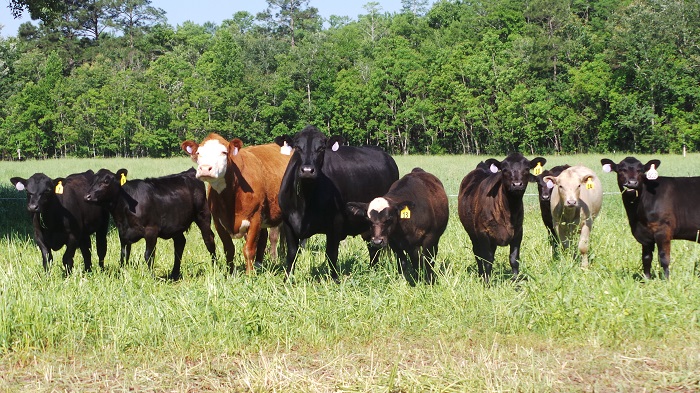
Washington County cattle in a controlled grazing system utilizing cool season forages this past spring.
Photo Credit: Mark Mauldin
While these recent “cool” snaps have provided a welcome break from the summer heat, they bring with them a reminder that production from perennial pasture grasses are slowing down and will soon be dormant for the winter. Deciding how to meet the nutritional needs of your cattle through the winter is one of the most important management decisions a cow-calf producer will make. There are many options for wintering cows. There is no one option that is the best for all operations. Below are some considerations to help you formulate your plan for this winter. All feeding programs should be based on efficiently meeting nutritional requirements.
Manage cows according to their nutritional requirements; they are not all the same. Larger heavier milking cows have higher nutritional requirements than do small lighter milking cows. Additionally, lactating cows have considerably higher nutrient requirements than dry cows. Young cows/heifers that are still growing while lactating have even higher nutritional demands. Feeding a dry cow to meet the demands of a lactating cow is a waste of money. Feeding a lactating cow to meet the demands of a dry cow will result in loss of body condition score and most likely reduced reproductive performance. In many cases addressing the varying nutritional demands relates more related to feed quality than quantity. If supply is limited, higher quality feedstuffs should be reserved for lactating cows. This scenario is particularly evident with hay and cool season forages. Hay quality varies tremendously. Feed the highest quality hay to the cows with the highest demands, this helps minimize the need for additional supplementation. When cool season forages are in short supply reserve them for the cows that need them most and will utilize their high quality the most effectively.
Understand the nutritional value of what you are feeding. Simply having hay or some other feed available for your cows will not ensure their nutritional requirements are being met. There are scenarios where the nutrient density of a feedstuff is so low that cows cannot physically consume enough feed to meet their needs. This scenario is most often associated with low quality hay or ensiled forages containing excessive amounts of water. Forage based feedstuffs (hay, baleage, grazed forages, etc.) can be sampled and analyzed to determine nutrient content. Processed or bagged feeds should come with a guaranteed analysis showing the nutritional makeup of the feed. Standard nutritional information for bulk commodity feeds is readily available. Sampling and lab analysis can be used to obtain information on specific loads of feed. If you know the nutrient requirements of your cows and the nutrient content of your feedstuffs, you can determine how much they need to consume to meet their requirements. Knowing how much of a particular feedstuff your cattle will require allows you to do economic comparisons of the different feeding options.
Always keep in mind a cow can only eat about 2% of her body weight in dry matter each day. Example: 2% of 1200lbs. is 24 lbs., so a 1200lb cow can eat about 24lbs of dry matter or about 27lbs of 12% moisture hay. No matter how cheap a feed is, if a cow can’t consume enough of it to meet her requirements it’s not going to be a good option.

Collecting samples and having an analysis performed on your hay will let you know the nutrient content. Knowing the nutrient content allows you to calculate what, if any, additional supplementation is required. Photo Credit: James Strickland
Use proper feeding/grazing techniques to help reduce feeding waste. Winter feeding is expensive. It incorporates seed and fertilizer costs associated with forage production, hay production and storage costs, purchased feed expenses, etc. It really does not matter the source of the cost, no winter feed is free, so don’t waste it.
- Be sure to use some type of hay feeding device; ring, rack, trailer, manger, something to prevent cows from standing on the hay while they eat it. Also try to avoid feeding more hay than the herd will consume in a few days. Feeding hay is an inherently wasteful process, do what you can to limit the waste.
- When grazing cool season forages utilize some form of rotational or controlled grazing. Cows don’t need access to these high quality forages 24-7. Providing cows with too much access to these forages allows them to selectively graze and trample more forage, which reduces the efficiency of forage utilization. It also does not allow the forage plants adequate opportunity for regrowth, and in turn greatly reduces total forage production. There are many grazing systems that can help maximize the productivity of cool season forages; consult your county agriculture agent for help determining which one would best suit your operation.
- When feeding a bagged or commodity feed, adequate bunk space is a primary concern. Space must be sufficient to feed the total amount of feed needed for the group of cows and to allow each animal sufficient access to the feed. Never bunk feed more than one day’s ration/supplement at one time; this will greatly increase the likelihood of waste, over-consumption, and possibly even cause digestive issues.
Grouping and feeding cows according to what they need, determining the most cost effective means by which to meet those needs, and minimizing waste will go a long way toward effectively and efficiently wintering cows. For more information on anything in this article or help addressing the many other factors associated with wintering cows, contact your county’s UF/IFAS Agriculture Agent.
- Peanut Maturity Update – 10/9/25 - October 10, 2025
- Fall Can be a Great Time for Vegetation Management - October 3, 2025
- Peanut Maturity Update – 9/25/25 Edition - September 26, 2025
